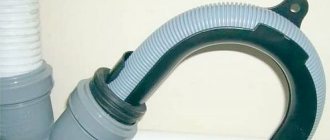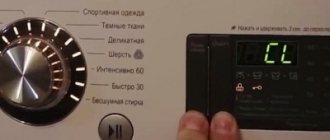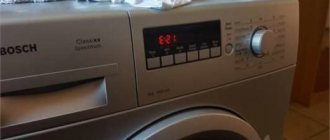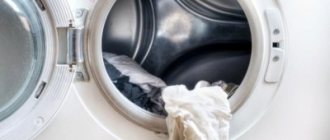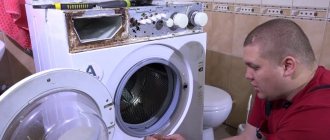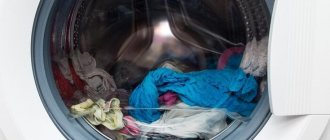The washing process seems to be proceeding, but the spin mode does not work. What to do: call a specialist, take the washing machine to a service center or buy a new one? It can be especially unpleasant if the cause of a “global” breakdown is clogged and worn brushes, which can be repaired yourself. If the washing machine does not spin out water, then you need to find out the reasons for the breakdown and further repairs, first check the operation of the program, and see if the spin function is disabled. It is necessary to exclude failure of several system components and other problems:
Drain malfunction
If the spin in the machine does not work for this reason, then you need to remove the hose from the sewer drain and place it at a lower level. Ideally - right on the floor. In fact, it will be enough to lower most of the hose (tube) lower than the washing machine tank so that the water begins to actively drain. The problem occurs in 2 cases:
- if the design has a bend in a flexible drain tube that works like a siphon;
- if the short drain tube or hose is dirty.
Picture 1
Draining water from a hose
The machine should drain the water. If this is not the case, then the spin mode does not work due to a malfunction of the hose and other elements:
- Filter. If the washing machine does not spin clothes and there is no drain, then there is a possibility of a blockage. In this case, water must be removed through the holes located before the drain pipe. All modern models have a filter that protects the drain pump from objects: paper clips, lumps of thread, small coins. Usually the filter is located on the front of the washing machine at the bottom. You can get to it through a round hatch by detaching the decorative panel that hides the base of the case.
Figure 2
You need to tilt the washing machine on its side, unscrew the filter and place it in a horizontal plane again. A water container is installed under the drain filter hole. This method is easy and effective. Removes water almost completely. There is a negative point - some of the water may spill on the floor.
- Emergency drain hose. Most washing machine models are equipped with a special flexible tube for emergency drainage, which is connected directly to the tank, bypassing the drain pipe and filter element. Some models have an emergency hose attached to the drain system after the filter. It may not turn on if the filter or pipe is dirty. In practice, removing water through the emergency tube takes a long time due to its small diameter. Typically, the emergency hose is located next to the filter (if there is a hatch) or on the other side under the removable panel. To drain the water using it, you will need to pull out the plug and direct the hose into the vessel.
Figure 3
Draining water through an emergency hose
No spin
If you have to take completely wet laundry out of the machine, this does not always mean that it’s time to get upset and prepare for the costs of repairing the washing machine. Modern models are equipped with many automatic protection systems. Therefore, the case when the spin does not work may not be caused by physical breakdowns of the mechanics or electronics. This is often due to user errors or obvious violations of the device operating rules.
- The housewife loads an excessive amount of laundry into the machine. The loading volume of the model is always indicated in the instructions for its use. And if you load more into the drum, it will simply stop. This is standard protection that is present in modern models and prevents engine overload.
- An error was made when selecting the washing mode. For example, many washing machines have the option of so-called delicate processing of laundry or hand washing. In these cases, spinning is not provided or is performed at very low speeds. As a result, wet laundry has to be removed from the drum. There is only one piece of advice: you need to choose the right washing mode before starting the machine.
- If the washing machine is controlled by mechanical buttons, the lack of spinning may be due to the accidental pressing of the corresponding switch, which turns it off. The same situation occurs when the contact groups of the control panel are excessively dirty.
- There are too few things in the drum. In this case, the sensors of modern models detect imbalance during rotation, and the machine stops spinning. This prevents damage to the mechanical parts of the drive and drum.
Rarely, a non-working spin cycle is associated with a broken pump. In this case, the machine runs the cycle normally. But due to the lack of water pumping, the laundry remains wet. However, this situation is very rare. Modern machines detect a pump malfunction, display errors or refuse to start the wash cycle.
Wrong program selected
Usually the spin mode in the washing machine does not work due to incorrectly configured software. There may be a problem with the washing program that was installed: the water does not pour out after the wash is completed, and the machine waits for the required command to drain the liquid and spin the clothes.
Figure 4
When the spin cancel button is pressed, it is depicted in the form of a spiral - crossed out with a line diagonally. If this button is pressed, the wash will not spin. Disable it to allow the process to resume.
The speed control is set to 0 - this is the reason why the washing machine does not spin the clothes, but drains the water.
Exceeding the range of motion inside the tank
Modern models of washing machines are programmed to detect the amplitude of vibrations of the laundry inside the tank during spinning. If the level of fluctuations exceeds the permissible norm, the device simply stops spinning the laundry. There may be several reasons for exceeding the amplitude of oscillations.
Incorrect installation of the washing machine
This often happens when the machine is installed on an uneven floor or an obstacle gets under the leg. To solve the problem, you need to adjust the legs of the device, preferably using a level. Use special pads or rubber mats to keep the machine stable.
Failure of shock absorbers
The task of shock absorbers in a washing machine is to dampen vibrations in the tank. The reason for premature wear of shock absorbers can be washing large masses of laundry, which during the spin cycle are constantly lumped together, creating an imbalance. As a result, the machine begins to jump, and the spin quality decreases significantly. If the shock absorbers do not work at all, then in this case the spin mode may not turn on. Replacing the shock absorbers will help solve the problem. In this case, it is best to seek professional help.
The pump is faulty or clogged
Figure 5
The most common problem is a clogged pump. When you remove the filter of the device, you can see the cross-shaped pump blades inside. You need to scroll them with your finger. If they don't spin, then something is stuck. Therefore, you should inspect the pump and remove the blockage inside.
If spinning occurs, but the water does not go down the drain, then the clothes remain wet after twisting. To repair, you need to change the pump. How to replace the pump in different models of washing machines:
- Turn off equipment from power sources, water supply, drainage.
- Mount the housing in a side position.
- Detach the bottom to gain access to the pump.
- Unscrew the screws and disconnect the pump by pressing on the side of the drain valve.
- Disconnect the wires from the pump.
- Remove the clamps and pour some of the water into the prepared vessel.
After this, you need to disassemble the pump, remove and clean the volute (if it is suitable for use) and change the pump. At the end, collect all the elements.
Signs of problems with spinning
The main sign of a malfunction in the spin system of a washing machine is wet laundry that is removed from the drum after the end of the cycle. Don’t immediately think that the unit is broken. Often the reason is an error in its operation due to setting the wrong mode.
There is no need to rush to get your laundry out of the machine. You should restart the program, making sure that the mode is set correctly and all parameters are set. Some models of washing machines allow you to simply repeat the spin cycle - this function can also be used. If the system fails and the program does not start, you need to look for the cause of the malfunction.
Laundry is not distributed correctly
A common reason why a washing machine does not spin. Modern machines recognize that objects are unevenly placed inside the drum and do not turn on the spin program until they have resolved the problem, or they stop the wash and indicate an error code on the screen.
To avoid this situation, you need to cancel the spin cycle when washing clothes, especially duvet covers. At the end of washing, rinsing and stopping, you need to take out the laundry and straighten it, and then throw it back into the drum and set the spin program.
Some machine models have a built-in function for analyzing the condition of the laundry: if the device has detected that the items do not meet the requirements, then you need to check the “No spin” button. It is possible that the no-twist function was enabled accidentally.
Correct operation
If you are faced with the problem that the washing machine has stopped spinning things, then you have neglected the operating recommendations.
As you know, a washing machine wrings things out only after washing, but the correctness of the latter is not so difficult to maintain.
To keep your machine always in shape, you need to adhere to the following:
- Empty your pockets of foreign iron objects.
- Use special bags for washing underwear.
- Sort clothes by size.
- Consider the dimensions and maximum capacity of the unit.
- Connect the machine to special surge protective devices.
Technical generator breakdown
A rare reason why the spin cycle does not work. Device malfunction occurs when the drum is frequently overloaded. If the loading rate specified by the manufacturer is regularly violated, this element may stop working in a short time. The tachogenerator is mounted on the shaft of the power unit and is designed to control speed during the washing process. If the sensor breaks, then the washing machine does not spin out the laundry; the rotation speed is not enough to perform this action.
Another reason for the malfunction of the tachogenerator is loosening of the contacts and wires leading to this element. To diagnose the problem, you need to check the fasteners and tighten them tighter.
Figure 6
If the wiring or adjacent contacts are damaged, they must be cleaned and taped. If the tachogenerator itself malfunctions, the part must be repaired or replaced.
Broken lock on the hatch
Sometimes the washing machine may start the washing process, but after a while it stops. The cause of the malfunction may be a failure of the hatch locking device. Repairing it yourself is labor-intensive and requires special skills and knowledge. To fix the problem, it is best to replace the UBL (hatch blocking device) with a new one.
Engine repair
The washing machine does not spin clothes due to a breakdown of the power unit? If the machine is equipped with a conventional belt motor rather than an inverter motor, the brushes will gradually wear out, causing a problem. If the motor is not running properly, the drum cannot reach the speed required for the final washing phase.
You can solve the problem yourself if you have mechanical knowledge: you need to remove the back wall of the case, then the strap from the electric motor and disconnect the wires, and then unscrew the electric motor itself from the drum. During diagnostics, faulty engine parts can be identified and replaced with new ones.
How to determine a power unit failure:
- if the engine sparks during the test, then the brushes need to be replaced;
- in case of strong noise and overheating of the equipment, the cause may be a violation of the integrity of the winding;
- peeling of the lamellas and the appearance of burrs on them entails the occurrence of sparks.
The lamellas should be checked during disassembly at the same time as the graphite brushes.
Figure 7. Engine.
Damages need to be eliminated as follows:
- Turn off the machine - disconnect drains, water pipes and electronic networks.
- Disassemble the product body: remove the panel and straps.
- Unscrew the bolts securing the engine.
- Disconnect terminals and wires connected to other elements.
- If the tank prevents access to the engine, you need to lift it.
- Different models have an individual device, so you need to remove the walls on the sides of the unit to properly remove the motor.
After this, you need to lift the broken elements or tighten their fastenings for normal operation.
Checking and repairing the pump in an Ariston car
The task is simplified when error code F 11 is displayed on the panel screen, confirming that the fault should be looked for in the drain pump.
First of all, you will have to find this node. To do this, the washing machine is laid on its side on a pre-spread cloth so as not to damage the panel. The screws are unscrewed and the bottom is removed. After this, the following algorithm is executed:
- The drain pipe is carefully probed. If a blockage is detected, the element will have to be removed;
- the clamp, the fixing element, is weakened;
- the bolts are unscrewed, after which the electrical wiring is disconnected;
- the pump is removed;
- The pipe is disconnected from the tank and washed under running water until completely clean.
A visual inspection of the pump is carried out. Quite often, poor pump performance is due to the fact that dirt has accumulated in it. You should wash it, install the element in place and check it with a multimeter. If there is no signal, the pump will have to be replaced. The same condition applies to the situation with a broken impeller.
Faulty motor brushes
Signs of breakdown: the machine sparks and does not gain speed during the spin cycle, and the parts themselves are worn out and come into weak contact with the collector. Because of this, the power unit does not create enough torque to rotate the drum during the spin cycle.
The washing machine does not spin: what to do or how to replace and change the brushes:
- Disconnect from the network.
- Close the water inlet valve.
- Drain some of the water from the tank by unscrewing the inlet pipe. Attention! Water may suddenly start flowing.
- Remove the lower front part by removing the drain filter and draining some of the water using an emergency hose.
- Position the machine so that it is convenient to work with it.
- After this, you need to remove the engine by removing the back cover - it is secured with screws.
- Remove the drive belt. To do this, pull it slightly towards you and turn the pulley counterclockwise.
- Take a photo of the location and connection of the wires and disconnect them.
- Inspect the motor without dismantling.
After that, proceed to replacement:
- Unscrew the brush holder bolts and remove;
- carefully select the carbon rods;
- remove the brush from the socket;
- install a new product;
- repeat the procedure for another carbon contact.
Figure 8.
Motor brushes
If the unit is equipped with a direct drive, then the sequence of actions is different:
- Remove the rear cover.
- Remove the rotor. This is required to access the brush holders.
- Replacement brush is similar. You need to watch the direction of sharpening.
Before installing new parts, you need to wipe the collector with a cotton swab to clean it of carbon deposits and dust.
Hall sensor check
The pressure switch is working, we begin to gradually approach the engine, having first checked the tachometer, which can also create problems. To diagnose it, the washing unit from Ariston should be disassembled by following these steps:
- the machine is disconnected from the electrical network, water supply and sewerage systems;
- the rear panel of the case is dismantled;
- The drive belt is removed by pulling it towards you, turning the pulley.
You can remove the electric motor by first remembering the wiring diagram. The fasteners are unscrewed, the motor is pulled out, after which the Hall sensor can be inspected.
The following reasons may contribute to its incorrect operation:
- loose fastenings;
- contacts have become disconnected.
This may be caused by constant vibration - tighten the bolts. Check the strength of the contacts.
Resistance is measured as follows:
- the tester is switched to the appropriate mode;
- the wiring connectors are released, which moves away from the contact group;
- Using probes stuck to the contacts, resistance is measured.
The tester switches to reading mode and determines whether there is current in the circuit. The pins are applied to the contacts and the motor is cranked manually. Changing the readings of the device will confirm the presence of current. After this, each wire is checked. If everything is in order, the reason for the lack of spin is not related to the tachogenerator.
It is believed that the tachogenerator rarely fails. But if this happens, it has to be changed immediately.
Checking the control module
This component is responsible for all machine system programs, in particular spin execution.
Figure 9.
Control module
The spin function cannot be started due to a module malfunction. You won’t be able to check the control unit at home, so you will need the help of a specialist.
If the control unit malfunctions, the technician diagnoses the board, replaces the broken parts with new ones, and then solders the tracks and contacts.
Bad spin
If the laundry is not wrung out well enough, it is recommended to seek qualified help. There are a number of standard reasons that service engineers eliminate.
- Clogged pipes and clogged filter. When dirt accumulates, water cannot be drained in the quantities provided for by the characteristics of the machine. It needs to be disassembled, cleaned or filters changed.
- The engine is faulty. In case of interturn short circuits and other non-critical failures, it continues to work. However, in spin mode, the motor cannot accelerate the drum to optimal speed. As a result, the laundry remains damp.
There are also problems in the control system. They are diagnosed quite simply. The machine freezes, does not start spinning, and cannot correctly execute the specified program.
Damage to shock absorbers and bearings
These products are used to dampen vibrations in the washing machine during washing and spinning. When they wear out, the device vibrates strongly, and the electronics do not spin the drum, and the spin mode in the washing machine does not work. It is also possible for the drum to knock on the body part.
If the bearings break, the seal gradually loses its tightness, liquid gets inside the products and washes out the lubricant. The bearings begin to rust and are destroyed by vibration. When the drum is shaken by hand, it dangles on the shaft. There may also be leaks on the outside of the tank. Bearings need to be replaced.
The washing machine does not want to spin - probable malfunctions
The list of breakdowns associated with spin failure is quite large. It includes both drive malfunctions and breakdowns of sensors, heating, control module and structural parts.
The motor brushes are worn out - from RUB 1,300*
The carbon brushes in brushed motors are responsible for transmitting voltage to the rotor so that it can rotate and the motor can run. Over time, parts wear out and contact becomes weaker. The engine starts running intermittently and picks up speed poorly. Perhaps the washer sparks at the bottom due to poor contact of the brushes with the commutator.
Worn brushes during washing and rinsing can be identified by slow rotation or jerking of the drum, as well as increased program time. During the spin cycle, the engine cannot gain speed, and the SMA turns off.
The brushes cannot be repaired; they need to be replaced with new ones.
Bearings are worn out - from RUB 3,000*
The drum on the shaft rotates easily thanks to bearings. Although the parts are protected by an oil seal, over time it leaks. The ingress of water gradually washes away the lubricant, and the bearings rust and collapse.
Because of this, the drum dangles on the shaft, rotates poorly and makes a lot of noise during the spin cycle when trying to gain speed. The washing machine does not spin clothes, although it seems to wash and rinse normally. But until the bearing fell apart completely.
It is better not to allow such a breakdown to occur and replace the bearings earlier at the first sign of failure. Otherwise, repairs may be much more expensive due to damage to the tank.
Control unit - from 1800 rubles*
The control module (electronic controller) is responsible for the operation and interaction of all SMA nodes. Due to voltage surges or moisture ingress, the part of the microcircuit that is responsible for controlling the spin cycle fails in the module. Radio components and tracks burn. As a result, the washing machine does not always spin or there is no spin at all (the washing machine spins the drum slightly at low speeds and ends the program).
The technician will inspect and test the control unit. Then he will replace faulty radio elements, solder the tracks and contacts. If a significant part of the board is burned out or the processor fails, the control unit is completely replaced.
From the experience of the masters! In most cases, we repair control boards in the workshop; this is done by a separate technician who specializes in repairing electronic components. A service technician who visits clients removes the control module and takes it to an electronics technician. The board is repaired within two to three days; after the repair, the service technician delivers and installs the working module back.
Belt - from 800 rubles*
All washing machines without direct drive have a belt. It transmits rotation from the engine to the drum shaft. During operation, the belt stretches, becomes rough and cracks. Therefore, it begins to slip at high speeds and when accelerating the engine. During washing and rinsing, belt stretching has little effect on rotation. During the spin cycle, when the rotation speed increases, the engine cannot “accelerate” the drum due to belt slippage. Therefore, the drum either spins without picking up speed, or the spin stops. Also, a stretched belt can fly off the pulley. Then the rotation of the drum stops completely.
To fix the damage, you need to replace the belt.
Tacho sensor or Hall sensor - from 1800 rubles*
The tachometer is responsible for controlling the drum speed. It measures the voltage inside the magnetic coil included in its design and sends signals to the control unit, through which it commands the engine what to do, increase speed or slow down.
A faulty tachometer transmits incorrect data to the module, so the command to the engine to “start acceleration” is not received. The SMA does not spin due to insufficient rotation speed of the drum, which rotates constantly, but too slowly.
If the mounting screw is loose, the Hall sensor may also be faulty due to an incorrect position on the shaft. In this case, the technician will tighten the fasteners and fix the sensor.
If the device breaks down, it will have to be replaced with a new one.
Shock absorbers - from 2000 rubles*
The SMA tank suspension includes springs and shock absorbers. They are responsible for protecting the body and other components of the machine from vibration when the drum rotates. Shock absorbers keep the tank in a stable moving state, but do not allow it to move to the sides and vibrate strongly.
Dampers have an expiration date. After the resource is exhausted, they weaken and even break. When the shock absorbers wear out, the tank dangles and vibrates too much. That's why the machine knocks and jumps even while washing. The spin cycle on the washing machine does not work because the control unit does not give the command to reach the maximum rotation speed due to strong vibration.
Shock absorbers need to be changed to restore balance to the tank. Replacement is carried out in pairs at once, because the rigidity of the old working damper and the new one are different. Therefore, it is simply not possible to select a similar one to an existing working one.
Motor - from 1800 rubles*
The machine stops spinning even after the motor breaks down. The cause is usually a short circuit or break in the rotor or stator windings. In a commutator engine, the lamellas can also peel off.
When the windings are broken or shorted, the motor most often stops turning on. Although sometimes it can rotate very slowly, the spin does not work.
The lamellas peel off due to the heating of the housing. The cause of overheating is usually a winding break, if it was missed and the machine was “driven” with a slow-running engine.
The engine cannot be repaired. Rewinding windings, centering, replacing lamellas costs the same as installing a new motor. Therefore, it is easier to install a new engine with a guarantee than to try to revive the old one.
Pressostat - from 1500 rubles*
If the level sensor fails, the washing machine does not spin clothes, thinking that the tank is full, and waits for the water to drain. Although there is no water, the pressure switch is stuck in the “full tank” position.
The level sensor is not directly connected to the spin control, but incorrect data affects the operation of the control unit, which must signal the engine to “start rotating and reach high speed” in order for the laundry to be wrung out.
When repairing, the master:
- will check the chamber with the membrane that measures pressure, remove any blockage that may confuse the sensor;
- will look at the pressure switch tube and blow it out, if necessary; if there is mechanical damage, the hose will have to be replaced;
- will put the tube back on the fitting if it has fallen off;
- will completely replace the pressure switch in the event of a sensor failure (this happens quite rarely).
Broken pressure switch
Signs of a faulty water level switch, as this part is also called, are problems with diagnostics, lack of liquid when starting the wash, and exceeding the normal water level. The problem leads to the start of the heating element, a malfunction of the heating device. The result is poorly wrung out laundry and water in the tank.
The problem is solved by reconfiguring the level relay. A specialist who understands washing machines of a certain brand has the right to do the work. If the issue cannot be resolved this way, then the pressure switch needs to be replaced with a new one.
Video
From the following video you will learn how to restore the spin cycle if one of the above problems occurs.
She graduated from the Institute of Tourism of the Federal Pedagogical University with a degree in Management, loves to travel and communicate with people. She is interested in psychology, enjoys dancing, and studies English. During the five years of maternity leave, I thoroughly mastered housekeeping, not forgetting about my own development. He skillfully uses words and can support a conversation on any topic thanks to his interest in different areas of life.
Found a mistake? Select it and click the buttons:
The first officially patented washing machine was made of wood and was a box with a frame, half filled with wooden balls. Laundry for washing and detergent were loaded inside and the frame was moved using a lever, which, in turn, made the balls move and grind the laundry.
History knows the fact that a kitten fell into the drum of a washing machine and, after going through a full wash cycle on the “Wool” program, got out of the unit unharmed. The only trouble for the pet was an allergy to washing powder.
Washing machines have something to do with the origin of the expression “money laundering.” In the 1930s, American gangsters used a network of laundries as a cover for their illegal activities. By passing off the proceeds of crime as proceeds from cleaning clothes, they turned “dirty” money into “clean” money.
Astronauts, while in Earth orbit, solve the problem of dirty things using an original method. Clothes are dropped from the spacecraft and burn up in the upper atmosphere.
There are a variety of balls that are used in the washing machine. Antistatic ones will prevent the fabric from sticking to the body after washing, balls with special loops will “comb” the lint and prevent the appearance of pills, and silicone ones with pimples will prevent fluff from matting when washing outerwear.
Washing machines equipped with the “No Iron” or “Easy Iron” functions can wash clothes with little to no wrinkling. This effect is achieved through a special approach to spinning - it is performed at low speeds, with long pauses, and a small amount of water is retained in the tank.
There is a washing machine “for bachelors”. Linen washed in such a unit does not need to be ironed at all! The thing is that the device does not have a drum: some things can be placed inside the container directly on hangers (for example, jackets and shirts), and smaller things (for example, underwear and socks) can be placed on special shelves.
For washing small items on the road or in a hotel, it is convenient to use a regular plastic bag. Socks or tights are kneaded inside a tied bag along with water and a small amount of detergent. This method allows you to pre-soak things and wash them without damaging the fabric or wasting a lot of powder and water.
Failure of the heating element
The heater wires are located close to the body part. Electrical wiring frays due to strong vibrations that are created during operation. The problem is solved by soldering the damaged sections or replacing the wires.
Figure 10.
If the heating element does not function due to scale, then you need to use a softener. This element may not work if the heating sensors and liquid level detection are faulty. In this case, instead of the heating element, you only need to replace the broken elements.
Preventing breakdowns in washing machines
It is possible to anticipate the occurrence of problems associated with increased noise levels, strong vibrations, and lack of a spin function if you adhere to the basic recommendations for the care and operation of equipment.
Experts advise doing the following with washing machines:
- load the volume of things without exceeding that specified in the machine’s passport;
- check for foreign objects in pockets;
- use covers for washing small items;
- less often include programs that involve working at high speeds and using hot water;
- clean filters regularly;
- Use only high-quality detergents and water softeners for washing.
In case of power surges, it is advisable to connect equipment to the network through surge protectors with a fuse or use a stabilizer.
Proper care and high-quality prevention will prevent malfunctions in the operation of the machine. You can learn about the weaknesses of individual brands from user reviews
If problems are identified, it is necessary to diagnose the product and replace failed components for the correct operation of the machine.
Timely and correct replacement of parts will extend the life of the equipment and prevent more serious breakdowns.
Let's sum it up
The article provided instructions on what to do if the washing machine does not spin clothes. All actions are conditionally divided into categories:
- Removing liquid from the tank.
- Finding out the reasons for the breakdown.
- Trying to fix it yourself.
The last point is the most important. If you can reconfigure the program or remove the clogged drain tube yourself, in which case incorrect actions will not cause harm, then replacing damaged parts is the responsibility of a specialist. If you suspect that the cause of the breakdown is in the control module, then it is better to take the device to a service center yourself. Only a professional workshop has equipment to diagnose it.
Some useful tips
It is recommended to prevent malfunctions in a timely manner rather than having to deal with washing machine repairs in the future. To do this, you should adhere to certain rules that do not cause difficulties.
When loading the drum with laundry, you must make sure that there are no foreign objects in the laundry. The installation of the Ariston washing machine and its connection must be carried out in accordance with the manufacturer's recommendations. Before you start washing, items should be sorted, and linen with decor should be washed in separate bags.
You should not overload the drum of the washing machine, as this accelerates its wear and affects the quality of the process. To protect the washing machine from sudden breakdowns, it is recommended to use a voltage control stabilizer.
The drain system filter is periodically cleaned and the washing powder tray is washed. After removing clean laundry, do not close the loading hatch door to avoid the appearance of fungus and mold.


